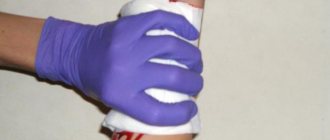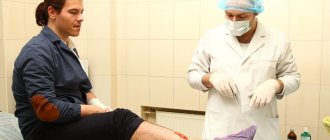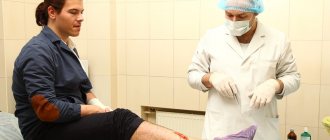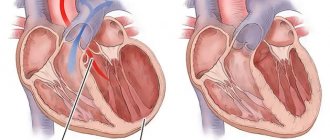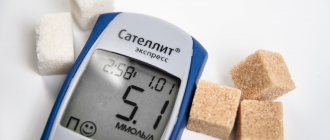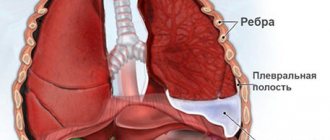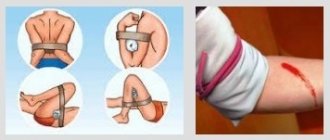Quickly and correctly provided first aid for bleeding is the key to a successful recovery of the victim.
The first aid algorithm depends on the type of bleeding. There are 4 types:
| Arterial | Represents the greatest danger. The blood flows quickly and is scarlet in color. |
| Venous | The blood flows out more slowly and is dark red in color. |
| Capillary | The blood comes out slowly and in a small volume, and has a bright red color. It may appear as small red drops on a person's skin. |
| Internal | The danger of this type of bleeding is that it is quite difficult to determine its presence in a person. Symptoms of internal bleeding depend on its location, most often the person becomes weak and pale, his pulse quickens (up to 140/min), he feels dizzy, has weak breathing, a swollen painful abdomen in the “embryo” position, and there may be a bruise on the abdomen. |
Types and signs of external bleeding
Methods to stop bleeding largely depend on their location. Each type has its own external manifestations, to which you need to react in time:
- capillary bleeding - occurs due to damage to small vessels as a result of injury or illness. It manifests itself first in the form of blood dew, and then as a slow flow of blood beyond the skin. This condition can be especially dangerous for people with bleeding disorders;
- internal (parenchymal) bleeding is a rather dangerous condition observed as a result of damage to internal organs that have a large blood supply network (spleen, liver, kidneys);
- arterial bleeding is the result of damage to the aorta, femoral and other arteries and manifests itself in the form of a stream of bright scarlet color with pulsation. The danger of such blood loss is its rapid nature, and therefore the timeliness of assistance in fractions of a second plays a vital role in avoiding death caused by damage to the main artery;
- venous bleeding is the slowest. The blood flows out thick, dark burgundy in color, and clots may form. Bleeding from a damaged vein is dangerous due to the detachment of a blood clot, significant loss of blood, or the entry of air bubbles into a pulmonary vessel.
AGAIN POINT BY POINT
- It is necessary to find the location of the damage.
- Raise and secure the limb.
- There is no time to clean and disinfect the wound if there is heavy blood loss - it is important to stop it, so ask the victim to press the vein with his hand below the injury site or do it yourself.
- A pressure bandage is applied below the cut or puncture site and can be made from any dressing material that is at hand: a bandage, a piece of clean cotton fabric, a handkerchief.
- Before you start bandaging, you need to place a cloth folded several times below the cut site, this way, when applying a bandage, you will achieve the necessary pressure on the lumen of the damaged vessels to reduce bleeding.
- The bandage should be made several times around the limb, starting from a thinner place. A positive result of first aid for venous bleeding is if the bleeding has stopped and the pulse can be felt below the bandage. This means that you managed to reduce the lumen of the blood vessels, but did not disrupt the blood supply.
- The victim must be taken to the hospital within 2 hours (in winter this period is halved) since an incorrectly applied, too tight bandage can cause tissue necrosis.
When small venous vessels are damaged, spontaneous formation of a blood clot occurs, and the bleeding stops on its own or after applying a pressure bandage. The blood loss in this case is small and is usually not life threatening. However, only a doctor can give a general assessment of the victim’s condition.
In case of damage to medium and large veins (jugular, subclavian and femoral), a favorable prognosis depends on timely assistance. Blood loss in a short time (30 to 50 minutes) can be fatal. A serious complication is the filling of the bed with an air plug (the vein fills with air during inhalation, when negative pressure is formed in it), which can lead to death from embolism earlier than from blood loss.
When providing first aid successfully, you need to remember that it is possible to finally stop bleeding from damaged vessels only in a medical institution.
First aid for venous bleeding
Blood clots that are bleeding from a vein should not be removed, as this may cause even greater blood loss. As first aid, apply a pressure aseptic bandage made of a strong bandage or fabric. If this method is ineffective, it is recommended to use a tourniquet. Under it, in order to avoid unwanted injury to the skin, there should be cotton wool or other soft material and a note with the time of application. The maximum duration of stay of the tourniquet on the victim’s body is 1 hour in the cold season (winter, autumn) and 2 hours in the warm season. If this time frame is exceeded, there is a risk of tissue anesthesia. Instead of a tourniquet, you can use various available materials - tight belts, ties, short sticks with fabric, twisted towels, etc.
Ways to stop bleeding
The method of stopping severe bleeding can be temporary or permanent. The first includes pre-medical manipulations. The final stop is made after hospitalization.
If the wound is small, then sometimes primary care is enough, the main methods are:
- Finger pinch.
- Application of a tourniquet.
- Tamponade.
- Use of improvised means.
Finger compression is most effective for minor bleeding. You cannot do without it in those places where it is not possible to apply a bandage:
- In the temporal part.
- On the face or neck.
- In the armpit area.
- In the area of the popliteal area, groin.
In case of extensive bleeding, a tourniquet must be applied. If you don’t have a special one, then you can take a belt or scarf.
It is important that the strip is wide, as thin ropes can cause necrosis. The tourniquet is placed on top of the fabric or clothing above the damage by 3-5 cm.
You can check the correctness of the action by checking the pulsation of the artery below the bandage; the pulsation should be weak or completely absent. The first turn is made tight, the subsequent ones a little weaker.
- Providing first aid for venous bleeding: point by point
In order not to severely compress the artery, it is necessary to remove the tourniquet for 10 minutes or loosen it after a certain period of time. In summer, the bandage can last 1-2 hours, in winter - 30-50 minutes.
It is recommended to record the time of application of the tourniquet on a piece of paper. The method is suitable for wounds of the hip and shoulder.
Tamponade is performed if emergency treatment with a tourniquet does not help. To do this, use a bandage or gauze, from which a tampon is formed to stop the bleeding. Fix it with a bandage . If it is not possible to use sterile materials, then it is necessary to disinfect a homemade tampon before clamping the artery.
Improvised means are used only as a last resort. To do this, take any clean clothing and tear it into strips suitable in width for the tourniquet. Alcohol, vodka, and tincture are used as a disinfectant.
Arterial bleeding - temporary cessation of arterial bleeding
First aid for bleeding from an artery requires special care, reactivity and speed. Make sure the victim has no fractures and elevate the injured limb. A tissue twist or tourniquet should be placed above the injury site. The time limit is the same as for stopping venous bleeding. Instead of fixing material, you can press the artery with your finger at the point of pulsation above the point of damage. If the ulnar, popliteal, femoral, or brachial arteries are bleeding, you need to fix the limb in the most bent and elevated position.
Application of a tourniquet
Effective first aid for bleeding requires 100% stopping of blood flow from the damaged blood vessel. If dressings, fabric twists and other available means are powerless in this matter, you should use a tourniquet. But remember that this is a last resort, since in most cases it leads to damage to tissue and nerve trunks. Application of a tourniquet is also indicated for traumatic amputation and difficulty determining the site of bleeding.
Extensive wounds
In this case, the rules for stopping arterial bleeding are somewhat different. The best method, available in any conditions, is to clamp the vessel slightly above the wound (a place located along the bloodstream closer to the heart). However, it is necessary to know exactly in which area the damaged artery is closest to the surface. This is where the vessel should be pressed against the bone.
Such an area can be identified by its characteristic pulsation. Once the point is found, it should be pressed down firmly. For such purposes, one finger is not enough. Clamping occurs with the entire palm or even a fist. If everything is done correctly, arterial bleeding stops immediately.
- Providing first aid for bleeding
However, it is very difficult to clamp the artery for even 15 minutes. And when transporting the victim, this may become impossible. Therefore, the above method is temporary. It makes it possible to treat the wound and prepare the necessary material to stop bleeding in other ways.
Main causes and symptoms
Capillaries are the smallest vessels, and in normal cases, their superficial damage to the skin does not pose any danger. Stopping the bleeding occurs on its own and does not require special action. The main sign of damaged capillaries is bright red blood. It flows slowly, there is no pulsation. The blood clotting system will work quickly. The vessel contracts, the blood flow slows down and stops due to the formation of a blood clot from platelets and fibrin fibers. Typically the process lasts up to 5 minutes.
Causes of capillary bleeding:
- abrasions, scratches and cuts;
- burns;
- low platelet concentration (thrombocytopenic purpura);
- decreased coagulability (hemophilia);
- pseudohemophilia - increased vascular permeability, causing spontaneous bleeding;
- oncology;
- purulent inflammation of the skin affecting the capillaries;
- atherosclerosis;
- hormonal imbalance, etc.
External bleeding is noticeable immediately, but internal bleeding (from the vessels of the stomach, uterus, intestines) is determined by the person’s condition. The main signs are weakness and drowsiness for no particular reason, pale skin, severe thirst, rapid pulse, decreased blood pressure. Sometimes the listed symptoms are accompanied by severe shortness of breath, nausea, fainting and dizziness. If first aid is not provided in time, internal capillary bleeding can be fatal.
State institution of the Republic of Kalmykia
Often, when bleeding, the victim experiences shortness of breath, with which he tries to compensate for the lack of oxygen, while complaining of a lack of air. Signs of massive blood loss: • pale skin; • cold sweat; • whiteness of lips; • drop in blood pressure; • increased heart rate. Arterial bleeding is characterized by a high intensity of blood loss, which can lead to death of the victim. The blood coming from the wound is bright scarlet, the stream flows like a fountain. Venous bleeding is characterized by less intensity, but if prolonged enough, it can lead to bleeding of the body. Venous blood is dark cherry in color and flows in a stream. Capillary bleeding occurs most often when capillaries are damaged; red blood flows evenly from the entire surface of the wound.
Based on localization, bleeding is divided into two types: Internal bleeding is characterized by the absence of blood appearing outside and its accumulation in the cavities or tissues of the body. External bleeding is characterized by the fact that blood flows out through a wound or natural openings of the body. Sometimes a combination of internal and external bleeding may occur. The discharge of blood through the mouth can be associated with bleeding from the lungs and upper respiratory tract, pharynx, esophagus, stomach and even duodenum. The discharge of foamy scarlet blood through the mouth is characteristic of pulmonary hemorrhage, and blood the color of “coffee grounds” is characteristic of gastric bleeding. The flow of blood or clear yellowish fluid from the ears in combination with different sizes of pupils (one larger than the other) indicates bleeding into the cavity of the skull and fractures of its bones.
Rules for stopping bleeding in case of damage to the carotid artery
In case of neck injuries, it is necessary to immediately seal the wound with any clean cloth or finger. The technique of applying a pressure bandage to the neck in case of damage to the carotid artery has the following feature: while squeezing the carotid artery on one side, it is necessary to avoid squeezing it on the opposite side. To do this, use a Kramer splint, an improvised splint, or the victim’s uninjured arm. Kramer's wire splint is a wire lattice, usually covered with cloth or bandage, for the convenience of the patient; due to the flexibility of the wire, it can take any shape necessary in the current situation. Wounds are mechanical damage to the skin, mucous membranes, deep tissues and organs. The size, depth and nature of the edges of the wound (abrasions, lacerations, cuts, puncture wounds, etc.) depend on the type of wounding object. The wound is always accompanied by pain and bleeding. As a result of injury, deeper soft tissue structures - tendons, nerves, large blood vessels - can be damaged. In addition, pathogenic microbes, which are causative agents of the inflammatory process, necessarily enter the wound. An open wound can also be exposed to adverse effects of the external environment. First aid for wounds includes stopping bleeding and protecting the wound from further damage, treating the area around the wound with iodine tincture and introducing infection by applying a sterile bandage. Bandages are used to cover damaged surfaces of the body from contamination (closing bandages), and to hold the dressing material on the surface of the body (fixing bandages). The closing bandage is also a hemostatic agent for venous and capillary bleeding.
WAYS TO STOP BLEEDING
There are temporary (preliminary) and permanent (final) stopping of bleeding.
Temporarily stopping external bleeding prevents life-threatening blood loss and allows you to gain time for transporting the victim, clarifying the diagnosis and preparing for the final stop of bleeding, which is carried out in a medical institution. Methods for temporarily stopping bleeding: • applying a hemostatic tourniquet; • pressing the bleeding vessel; • applying a pressure bandage; • giving an elevated position to the injured limb; • forced flexion and fixation of the limb. To briefly stop bleeding in order to gain time to apply a tourniquet, twist, or pressure bandage, pressure can be applied to a blood vessel at or above the site of injury. You can press the vessel with your fingers, fist or the edge of your palm. To effectively press the vessel to the bone formations, it is necessary to know the typical points where the artery passes next to the bone on one side and close to the surface of the skin. To stop external bleeding from the soft tissues of the head, if the use of an antiseptic (sterile) bandage is ineffective, the carotid artery on the side of the injury is digitally pressed against the carotid tubercle of the transverse process of the seventh cervical vertebra. Finger pressure of the temporal artery to the temporal bone should be carried out in the temple area in front of and above the tragus of the ear. When bleeding from wounds of the upper extremities, apply pressure. • axillary artery to the head of the humerus in the axillary fossa; • brachial artery to the humerus in the upper third of the inner surface of the shoulder; • radial artery to the radial bone at the point where the pulse is determined; • ulnar artery to the ulna in the upper third of the inner surface of the forearm. Pressing of large vessels of the lower extremities is carried out in the following places: • femoral artery - below the middle of the inguinal fold to the pubic bone; • popliteal artery - in the center of the popliteal fossa to the articular end of the femur; • posterior tibial artery - to the posterior surface of the inner malleolus. A pressure bandage is used to stop bleeding on the torso, as well as for venous bleeding or bleeding from small arteries of the extremities. A tight pressure bandage can be effective for arterial bleeding from the gluteal region, blood vessels of the hands, and feet. A sterile cotton-gauze pad is used, followed by tight bandaging. To stop bleeding on the torso, this method is the only one.
Tight wound packing is used for fairly deep soft tissue injuries. Gauze swabs are tightly inserted into the wound and a pressure bandage is applied. Tight packing of the nasal passages with cotton wool or gauze balls is used to stop nosebleeds. Forced flexion and fixation of the limb is used for damage to the subclavian artery, vessels of the forearm and lower leg. When bleeding from vessels in the shoulder joint or subclavian region, the upper limb is retracted as far as possible and is fixed in this position with a bandage. When bleeding from the arteries of the forearm and lower leg, use the position of maximum flexion, respectively, in the elbow and knee joints. Such fixation can only be carried out if the bones of the limbs are intact and can be designed for a short period of time - until a tourniquet or pressure bandage is applied. Elevating the injured limb is one of the additional methods of temporarily stopping bleeding from small vessels of the limb.
The application of a hemostatic tourniquet is used for injury to the extremities, complicated by damage to large arterial and venous trunks, as well as for arterial bleeding, which is very difficult to stop by other methods of temporary stop.
Wide elastic materials can be used as a tourniquet (a wide belt, a bandage folded in several layers, suspenders, a piece of fabric, etc.). Do not use ropes, electrical wires, narrow belts, etc. When applying a tourniquet to the limbs, choose a place above the wound and as close as possible to it, so that the part of the limb deprived of blood supply is as short as possible. The tourniquet cannot be applied to bare skin, so as not to cause pinching; it should be covered with a strip of fabric (your own clothing, several layers of gauze bandage). A strongly stretched tourniquet is placed under the limb and wrapped around the limb several times until bleeding from the wound stops or the pulse disappears below the site where the tourniquet was applied. The coils of the harness should be located next to each other. The ends of the harness are fixed over all turns. After applying a tourniquet, you must place a note under the tourniquet indicating the time the bleeding stopped or write this information directly on the limb.
If the tourniquet is applied correctly, the bleeding will stop, the pulse in the periphery will not be detected, and the skin of the limb will become pale. In the cold season, the limb tied with a tourniquet must be well wrapped in clothing. In case of long-term transportation of the victim to a medical facility, after 1.5 hours, despite the threat of re-bleeding, the tension of the tourniquet should be loosened for a few minutes so that the bloodless limb is filled with blood, and then tighten it again. It should be remembered that the tourniquet should remain on the limb for no more than 1-1.5 hours in the summer and 0.5 hours in the winter. Leaving a tourniquet on a limb for more than 1.5 hours can lead to necrosis of the limb.
If you don’t have a rubber band on hand, you can use improvised means to apply a twist. A piece of fabric, a waist belt, women's tights, a scarf and other available material may come in handy. The fabric used for twisting is wrapped in a selected place on the limb, the two ends are loosely tied, a stick or plank is inserted into the resulting loop and they begin to make rotational movements, achieving a complete stop of bleeding, after which the stick is fixed on the limb. When applying a twist, it is also necessary to indicate the exact time of stopping the bleeding to prevent further necrosis of the limb.
The main types of bandages Circular - the turns of the bandage completely cover each other. Spiral - each turn of the bandage partially covers the previous one. Cross-shaped, spica-shaped and eight-shaped - the turns of the bandage intersect each other transversely or diagonally. To make dressings, an individual dressing package (IPP), gauze wipes, bactericidal plaster, and bandages are used. Bandages come in different lengths and widths and are made from different materials. The first aid kit for providing first aid to workers includes bandages with a width of 5, 7, 10, 14 cm.
RULES AND TECHNIQUES FOR APPLYING BANDAGES ON WOUNDS
Before applying a bandage, it is necessary to clear the wound area, treat the skin around the wound with tincture of iodine, brilliant green solution, hydrogen peroxide or boiled water with the addition of potassium permanganate (Fig. 81). To reduce physical suffering from the wound, the victim must be given an anesthetic or antispasmodic (baralgin, analgin, spasgan, etc.). To protect the wound from infection, you should not touch it with your hands, and you should not cough on the part of the bandage that will come into contact with the wound. For small wounds, the dressing can be held in place with bandage-free dressings, such as strips of adhesive tape. During dressing, it is advisable to be facing the victim to monitor his condition and reaction, avoiding causing additional suffering, and to have a constant conversation with him. The bandage should be started from a narrower place, gradually moving to a wider one. You need to start the bandage (Fig. 82) from the first turn so that one end of the bandage or fabric protrudes from under the next turn. In this case, it can be bent and secured with the next turn, applied in the same direction. The bandage should roll out evenly over the surface of the body. The width of the bandage must be selected so that it is equal to or greater than the diameter of the body part being bandaged. Using a narrow bandage increases dressing time. The bandage must be held so that its free end makes a right angle with the hand in which it is located. The dressing must be completed with a fixing circular tour.
How to quickly stop bleeding?
Small injuries can be easily localized by applying pressure to the wound for 5 minutes with a hand or cloth to form a blood clot. For cut wounds, the edges will stick together after some time. The skin around the wound is carefully wiped with the available antiseptic, then a bactericidal patch or sterile bandage is applied.
If a deep venous injury with drip bleeding is detected, it is necessary to sit or lay the victim down in order to elevate the damaged area above the heart. A hemostatic sponge is applied to painful large wounds, securing it with a bandage. The sponge gradually dissolves on its own; there is no need to remove it. In the absence of a sponge, apply a pressure bandage to the wound. Gauze folded in 2-3 layers and a bandage for fixation are suitable. If blood has leaked through the bandage, apply a piece of cotton wool and bandage again over the first bandage.
With internal bleeding, the victim feels drowsiness, weakness, and wants to drink. The pulse quickens, the pressure drops, the head is dizzy. Damage to the stomach is indicated by vomiting blood, intestines - tar-like stool, rectum - scarlet blood in the stool, ureters - red urine. If internal capillary bleeding is suspected, first aid will be to lie the victim down and apply cold to the damaged area. Then the doctors who arrived to the call act.
